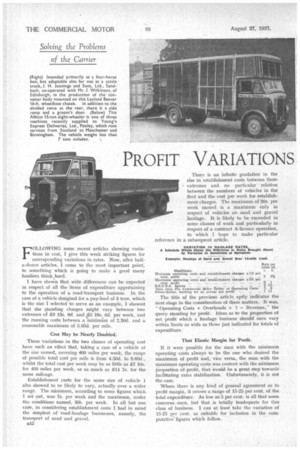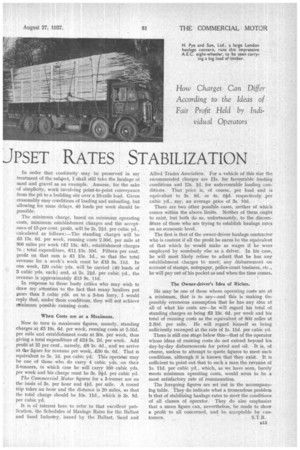PROFIT VARIATIONS JPSET RATES STABILIZATION
Page 46

Page 47

If you've noticed an error in this article please click here to report it so we can fix it.
FOLLOWING some recent articles showing variations in cost, I give this week striking figures for corresponding variations in rates. Now, after halfa-dozen articles, I come to the most important point, to something which is going to make a good many' hauliers thirkhard.
I have shown that wide differences can be expected in respect of all the items of expenditure appertaining to the operation of a road-transport business, in the case of a vehicle designed for a pay-load of 3 tons, which is the size I selected to serve as an example, I showed that the standing charges might vary between two extremes of RS 13s. fkl. and ,e,5 18s. 6d. per week, and the running costs between a minimal of 2.30d. and a seasonable maximum of 5.05c1. per mile.
Cost May be Nearly Doubled.
These variations in the two classes of operating cost have such an effect that, taking a case of a vehicle of the size named, covering 400 miles per week, the range of possible total cost per mile is from 4.50d. to 8.60d., whilst the total cost per week may he as little as £7 10s. for 400 miles per week, or as much as £14 7s. for the
same mileage.
Establishment costs for the same size of vehicle I also showed to be likely to vary, actually over a wider range. The minimum, according to some figures which I set out, was 7s. per week and the maximum, under the conditions named, 30s. per week. In all but one case, in considering establishment costs I had in mind the simplest of' road-haulage businesses, namely, the transport of sand and gravel. There is an infinite gradation in the rise in establishment costs between these extremes and no particular relation between the numbers of vehicles in the fleet and the cost per week for establishment charges. The maximum of 30s. per week named is a maximum only in respect of vehicles on sand and gravel haulage. It is likely to be exceeded in some classes of work and particularly in respect of a contract A-licence operation, to which I hope to make particular reference in a subsequent article.
VARIATION IN HAULAGE RATES.
A Schedule Which Shows the Difference in Rates Brought About by Variation in Conditions or Operation,
Example: Haulage of Sand a—ridGravel Over 10-mile Lend.
Rate per cubic yd.
Clonelitions. d. Minimum operating costa and establishment charges -I-15 per
cenL profit ... Maximum operating costs and'Charges -Vi5 per
eent. profit 5 1 B.S.A.T.A. figures... 3 10 Data lrom Tlis Commercial Motsr Tables of Operating Costs 3 Si
Owner-driver, working for no actual net profit ... 1 11
The title of the previous article aptly 'indicates the• next stage in the consideration of these matters. It was, "Operating Costs + Overheads + ? = Revenue," the query standing for profit. Ideas as to the proportion of net profit which a haulage business should earn vary within limits as wide as those just indicated for totals of expenditure.
That elastic Margin for Profit.
If it were possible for the man with the minimum operating costs always to be the one who desired the maximum of profit and, vice versa, the man with the maximum operating costs was content with the minimum Proportion of profit, that would be a great step towards facilitating rates stabilization. Unfortunately, it is not the case.
Where there is any kind of general agreement as to profit margin, it covers a range of 15-25 per cent. of the total expenditure. As low as 5 per cent. is all that some concerns . earn, but that is totally inadequate for this class of business. I can at least take the variation of 15-25 per cent. as suitable for inclusion in the comparative figures which follow. In order that continuity may be preserved in my treatment of the subject, I shall still take the haulage of sand and gravel as an example. Assume, for the sake of simplicity, work involving point-to-point conveyance from the pit to a building site over a 10-mile lead. Given reasonably easy conditions of loading and unloading, but allowing for some delays, 40 loads per week should be possible.
The minimum charge, based on minimum operating costs, minimum establishment charges and the acceptance of 15-per-cent. profit, will be 2s. 21d. per cubic yd., calculated as follows :-The standing charges will be 23 13s. 6d. per week, running costs 2.30d. per mile at SOO miles per week (£7 13s. 4d), establishment charges
; total expenditure, £11 13s. 10d. Fifteen per cent profit on that sum is £1 15s. id., so that the total revenue for a week's work must be £13 8s. lid. In one week, 120 cubic yds. will be carried (40 loads of 3 cubic yds. each) and, at 2s. 21d. per cubic yd., the revenue is approximately £13 8s. lid.
In response to those hasty critics who may wish to draw my attention to the fact that many hauliers put wore than 3 cubic yds. on to a 3-ton lorry, I would reply that, under those conditions, they will not achieve nainimum possible running costs.
When Costs are at a Maximum.
Now to turn to maximum figures, namely, standing charges at £5 18s. 6d. pet week, running costs at 5.05d. per mile and establishment costs at 30s. per week, thus giving a total expenditure of £24 5s. 2d. per week. Add profit at 25 per cent., namely, 26 ls. 4d., and we arrive at the figure for revenue per week, £30 6s. 6d. That is equivalent to 5s. id. per cubic yd. This operator may be one of those who do carry 4 cubic yds. on their 34onners, in which case he will carry 160 cubic yds. per week and his charge must be 3s. aild. per cubic yd.
The Commercial Motor figures for a 3-tonner are on the basis of 3s. per hour and 41d. per mile. A round trip takes an hour and the distance is 20 miles, so that the total charge should be 10s. 11d., which is 3s. 8d. per cubic yd.
It is of interest here to refer to that excellent publication, the Schedules of Haulage Rates for the Ballast and Sand Industry, issued by the Ballast, Sand and Allied Trades Asociation. For a vehicle of this size the recommended charges are Ils, for favourable loading conditions and 12s. id. for unfavourable loading conditions. That price is, of course, per load and is equivalent to 3s. 8d. or 4s. Oid. respectively per cubic yd., say, an average price of 3s. 10d.
There are two other possible cases, neither of which comes within the above limits. Neither of them ought to exist, but both do so, unfortunately, to the discomfiture of those who are trying to establish haulage rates on an economic level.
The first is that of the owner-driver haulage contractor who is content if all the profit he earns be the equivalent of that which he would make as wages if he were employed by somebody else as a driver. In his case, he will most likely refuse to admit that he has any establishment charges to meet; any disbursement on account of stamps, notepaper, police-court business, etc., he will pay out of his pocket as and when the time comes.
The Owner-driver's Idea of Riches. '
He may be one of those whose operating costs are at a minimum, that is to say-and this is making the possibly erroneous assumption that he has any idea at all of what his costs are-he will regard his total of standing charges as being £3 13s. 6d. per week and his total of running costs as the equivalent of 800 miles at 2.30d. per mile. He will regard himself as being sufficiently recouped at the rate of 1s. lid, per cubic yd.
There is still one stage below this-that of the operator whose ideas of running costs do not extend beyond his day-by-day disbursements for petrol and oil. It is, of course, useless to attempt to quote figures to meet such conditions, although it is known that they exist. It is sufficient to point out that to such a man the revenue of
11d. per cubic yd., which, as we have seen, barely meets minimum operating costs, would seem to be a most satisfactory rate of remuneration.
The foregoing figures are set out in the accompanying table. They do indicate what a tremendous problem is that of stabilizing haulage rates to meet the conditions of all classes of operator. They do also emphasize that a mean figure can, nevertheless, be made to show a profit to all concerned, and be acceptable by cus tomers. S.T.R.




















































































